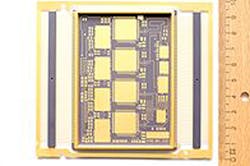With low-temperature co-fired-ceramic (LTCC) technology, multiple passive components can be embedded in a single, compact, surface-mount-technology (SMT) unit. Because bare die or SMT packaged parts also can be made an integral part of the LTCC component, it can include multiple technologies and thus deliver increased functionality. In a six-page white paper titled “LTCC Technology Overview,” Plextek RF Integration covers LTCC from its origins to current design recommendations and advice.
LTCC was developed from a multilayer capacitor-fabrication technology. Ceramic material is manufactured from a mixture of organic and inorganic materials to form a thin, flexible tape. At this point, the material is quite fragile. It is therefore used to sandwich multiple ceramic layers—a process in which each LTCC component is fabricated from multiple tape layers that are processed in parallel. To enable complex functionality, LTCC allows the different patterning of metals and resistive materials on the separate layers.
A variety of LTCC substrate materials are available. They boast dielectric constants ranging from 6 to 10. The individual tape layers are generally 100 to 200 μm thick. An LTCC stack usually has a maximum of 20 to 30 layers, with 6 to 8 layers needed at minimum to avoid warping. Usually, the LTCC stack will be 0.8 to 6.0 mm thick with a maximum substrate size of 100 mm2.
In addition to the potential for substrate warping, LTCC suffers some other limitations. Because metallization is screen printed, for example, LTCC’s definition is limited compared to thin-film options. In addition, the substrate is not polished, which can result in higher losses. Processing LTCC also is more costly than it is for multilayer laminates. At four to eight weeks, processing lead times are longer as well.
For applications that can trade off those drawbacks, however, the benefits are many. Among LTCC’s numerous strengths are that it offers size benefits, thanks to its multilayer circuitry and high dielectric constant. It also provides control of dielectric properties—thickness in addition to dielectric constant. Notably, LTCC boasts a low loss tangent. Printed resistor, inductor, and capacitor (RLC) components can be integrated.
For example, resistors can be included in LTCC components by printing an additional resistive ink as part of the processing. Their length and width is constrained by a minimum size of roughly 0.38 mm. Because resistors can be printed on any tape layer, it is simple enough to include buried resistors within the LTCC stackup. Tolerance is limited with such capacitors, however, and all resistive inks are not suitable for buried structures. The note also details the integration of capacitors and inductors before concluding with recommendations and advice for LTCC-component design.
Plextek Ltd., London Rd., Great Chesterford, Essex, CB10 1NY, United Kingdom; +44 (0) 1799 533200.
About the Author

Nancy Friedrich
RF Product Marketing Manager for Aerospace Defense, Keysight Technologies
Nancy Friedrich is RF Product Marketing Manager for Aerospace Defense at Keysight Technologies. Nancy Friedrich started a career in engineering media about two decades ago with a stint editing copy and writing news for Electronic Design. A few years later, she began writing full time as technology editor at Wireless Systems Design. In 2005, Nancy was named editor-in-chief of Microwaves & RF, a position she held (along with other positions as group content head) until 2018. Nancy then moved to a position at UBM, where she was editor-in-chief of Design News and content director for tradeshows including DesignCon, ESC, and the Smart Manufacturing shows.
